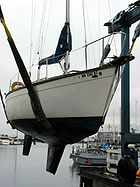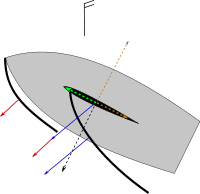
Keel
Encyclopedia

Ship naming and launching
The ceremonies involved in naming and launching naval ships are based in traditions thousands of years old.-Methods of launch:There are three principal methods of conveying a new ship from building site to water, only two of which are called "launching." The oldest, most familiar, and most widely...
is considered more significant in its creation.
The word can also be used to refer to a complete boat, as in keelboat
Keelboat
Keelboat has two distinct meanings related to two different types of boats: one a riverine cargo-capable working boat, and the other a classification for small- to mid-sized recreational sailing yachts.-Historical keel-boats:...
or Humber keel
Humber Keel
The Humber Keel was a type of sail craft used for inshore and inland cargo transport around Hull and the Humber Estuary, in the United Kingdom, particularly through the late 19th and early 20th centuries....
.
Structural keels

Ship
Since the end of the age of sail a ship has been any large buoyant marine vessel. Ships are generally distinguished from boats based on size and cargo or passenger capacity. Ships are used on lakes, seas, and rivers for a variety of activities, such as the transport of people or goods, fishing,...
is built. The keel runs in the middle of the ship, from the bow
Bow (ship)
The bow is a nautical term that refers to the forward part of the hull of a ship or boat, the point that is most forward when the vessel is underway. Both of the adjectives fore and forward mean towards the bow...
to the stern
Stern
The stern is the rear or aft-most part of a ship or boat, technically defined as the area built up over the sternpost, extending upwards from the counter rail to the taffrail. The stern lies opposite of the bow, the foremost part of a ship. Originally, the term only referred to the aft port section...
, and serves as the foundation
Foundation (architecture)
A foundation is the lowest and supporting layer of a structure. Foundations are generally divided into two categories: shallow foundations and deep foundations.-Shallow foundations:...
or spine of the structure, providing the major source of structural strength of the hull. The keel is generally the first part of a ship's hull to be constructed, and laying the keel, or placing the keel in the cradle in which the ship will be built, is often a momentous event in a ship's construction — so much so that the event is often marked with a ceremony, and the term lay the keel has entered the language as a phrase meaning the beginning of any significant undertaking. Modern ships are now largely built in a series of pre-fabricated, complete hull sections rather than being built around a single keel, so the start of the shipbuilding process is now considered to be when the first sheet of steel
Steel
Steel is an alloy that consists mostly of iron and has a carbon content between 0.2% and 2.1% by weight, depending on the grade. Carbon is the most common alloying material for iron, but various other alloying elements are used, such as manganese, chromium, vanadium, and tungsten...
is cut.

Scantling
Scantling is a measurement of prescribed size, dimensions, or cross sectional areas. For comparison, see Form Factor: -Shipping:In shipbuilding, the scantling refers to the collective dimensions of the various parts, particularly the framing and structural supports. The word is most often used in...
s, but there is always a problem of the increased draft with no additional cargo capacity. If a double bottom is fitted, the keel is almost inevitably of the flat plate type, bar keels often being associated with open floors, where the plate keel may also be fitted.
Duct keels are provided in the bottom of some vessels. These run from the forward engine room bulkhead to the collision bulkhead and are utilized to carry the double bottom piping. The piping is then accessible when cargo is loaded.
If a ship suffers severe structural stress — classically during a shipwreck
Shipwreck
A shipwreck is what remains of a ship that has wrecked, either sunk or beached. Whatever the cause, a sunken ship or a wrecked ship is a physical example of the event: this explains why the two concepts are often overlapping in English....
when running aground in a heavy sea — it is possible for the keel to break or be strained to the extent that it loses structural integrity. In this case the ship is commonly said to have "broken its back". Such a failure means that the entire structure of the ship and its machinery has been compromised and repairing such damage would require virtually re-building the ship from the ground up. A ship that has broken its back is almost certainly unsalvagable
Marine salvage
Marine salvage is the process of rescuing a ship, its cargo, or other property from peril. Salvage encompasses rescue towing, refloating a sunken or grounded vessel, or patching or repairing a ship...
and subsequently written off by its insurers.
Hydrodynamic keels

Non-sailing keels
The keel surface on the bottom of the hull gives the ship greater directional control and stability. In non-sailingSailboat
A sailboat or sailing boat is a boat propelled partly or entirely by sails. The term covers a variety of boats, larger than small vessels such as sailboards and smaller than sailing ships, but distinctions in the size are not strictly defined and what constitutes a sailing ship, sailboat, or a...
hulls, the keel helps the hull to move forward, rather than slipping to the side. In traditional boat building, this is provided by the structural keel, which projects from the bottom of the hull along most or all of its length. In modern construction the bar keel or flat-plate keel performs the same function. There are many types of fixed keels, including full keels, long keels, fin keels, winged keel
Winged keel
A winged keel is a sailboat keel, usually of moderate aspect ratio, that uses a nearly horizontal foil, the "wing", at the bottom to provide additional performance. Note that the wing is upside down with relation to the boat...
s, bulb keel
Bulb keel
200px|right|Flat Keel bulbA bulb keel is a keel, usually made with a high aspect ratio foil, that contains a ballast-filled bulb at the bottom, usually teardrop shaped. The purpose of the bulb keel is to place the ballast as low as possible, therefore gaining the maximum possible amount of...
s, and bilge keels among other designs. Deep draft ships will typically have a flat bottom and employ only bilge keels, both to aid directional control and to damp rolling motions
Sailboat keels
In sailboatSailboat
A sailboat or sailing boat is a boat propelled partly or entirely by sails. The term covers a variety of boats, larger than small vessels such as sailboards and smaller than sailing ships, but distinctions in the size are not strictly defined and what constitutes a sailing ship, sailboat, or a...
s, keels use the forward motion of the boat to generate lift
Lift (force)
A fluid flowing past the surface of a body exerts a surface force on it. Lift is the component of this force that is perpendicular to the oncoming flow direction. It contrasts with the drag force, which is the component of the surface force parallel to the flow direction...
to counteract the leeward force of the wind. The rudimentary purpose of the keel is to convert the sideways motion of the wind when it is abeam into forward motion. A secondary purpose of the keel is to provide ballast.

Centreboard
A centreboard or centerboard is a retractable keel which pivots out of a slot in the hull of a sailboat, known as a centreboard trunk or centerboard case...
s and other types of foils in that keels are made of heavy materials to provide ballast
Sailing ballast
Ballast is used in sailboats to provide moment to resist the lateral forces on the sail. Insufficiently ballasted boats will tend to tip, or heel, excessively in high winds. Too much heel may result in the boat capsizing. If a sailing vessel should need to voyage without cargo then ballast of...
to stabilize the boat. Keels may be fixed, or non-movable, or they may retract to allow sailing in shallower waters. Retracting keels may pivot (a swing keel) or slide upwards to retract, and are usually retracted with a winch
Winch
A winch is a mechanical device that is used to pull in or let out or otherwise adjust the "tension" of a rope or wire rope . In its simplest form it consists of a spool and attached hand crank. In larger forms, winches stand at the heart of machines as diverse as tow trucks, steam shovels and...
due to the weight of the ballast. Since the keel provides far more stability when lowered than when retracted (due to the greater moment
Moment (physics)
In physics, the term moment can refer to many different concepts:*Moment of force is the tendency of a force to twist or rotate an object; see the article torque for details. This is an important, basic concept in engineering and physics. A moment is valued mathematically as the product of the...
arm involved), the amount of sail carried is generally reduced when sailing with the keel retracted.
Types of non-fixed keels include swing keels and canting keel
Canting keel
A canting keel is a form of sailing ballast, suspended from a rigid canting strut beneath the boat, which can be swung to windward of a boat under sail, in order to counteract the heeling force of the sail...
s. Canting keels can be found on racing yachts, such as those competing in the Volvo Ocean Race
Volvo Ocean Race
The Volvo Ocean Race is a yacht race around the world, held every three years. It is named after its current owner, Volvo...
. They provide considerably more righting moment as the keel moves out to the windward-side of the boat while using less weight. The horizontal distance from the weight to the pivot is increased, which generates a larger righting moment.
Etymology
The word "keel" comes from Old EnglishOld English language
Old English or Anglo-Saxon is an early form of the English language that was spoken and written by the Anglo-Saxons and their descendants in parts of what are now England and southeastern Scotland between at least the mid-5th century and the mid-12th century...
cēol, Old Norse
Old Norse
Old Norse is a North Germanic language that was spoken by inhabitants of Scandinavia and inhabitants of their overseas settlements during the Viking Age, until about 1300....
kjóll, = "ship
Ship
Since the end of the age of sail a ship has been any large buoyant marine vessel. Ships are generally distinguished from boats based on size and cargo or passenger capacity. Ships are used on lakes, seas, and rivers for a variety of activities, such as the transport of people or goods, fishing,...
" or "keel". It has the distinction of being regarded by some scholars as the very first word in the English language recorded in writing, having been recorded by Gildas
Gildas
Gildas was a 6th-century British cleric. He is one of the best-documented figures of the Christian church in the British Isles during this period. His renowned learning and literary style earned him the designation Gildas Sapiens...
in his 6th century Latin
Latin
Latin is an Italic language originally spoken in Latium and Ancient Rome. It, along with most European languages, is a descendant of the ancient Proto-Indo-European language. Although it is considered a dead language, a number of scholars and members of the Christian clergy speak it fluently, and...
work De Excidio et Conquestu Britanniae
De Excidio et Conquestu Britanniae
De Excidio et Conquestu Britanniae is a work by the 6th-century British cleric Gildas. It is a sermon in three parts condemning the acts of Gildas' contemporaries, both secular and religious, whom he blames for the dire state of affairs in sub-Roman Britain...
, under the spelling cyulae (he was referring to the three ships that the Saxons
Saxons
The Saxons were a confederation of Germanic tribes originating on the North German plain. The Saxons earliest known area of settlement is Northern Albingia, an area approximately that of modern Holstein...
first arrived in).
Carina is the Latin
Latin
Latin is an Italic language originally spoken in Latium and Ancient Rome. It, along with most European languages, is a descendant of the ancient Proto-Indo-European language. Although it is considered a dead language, a number of scholars and members of the Christian clergy speak it fluently, and...
word for "keel" and is the origin of the term careen (to clean a keel and the hull in general, often by rolling the ship on its side). An example of this use is Careening Cove, a suburb of Sydney, Australia, where careening was carried out in early colonial days.
See also
- LeeboardLeeboardA leeboard is a lifting foil used by a sailboat, much like a centerboard, but located on the leeward side of the boat. The leeward side is used so that the leeboard isn't lifted from the water when the boat heels, or leans under the force of the wind....
- BilgeboardBilgeboardA bilgeboard is a lifting foil used in a sailboat, which resembles a cross between a centerboard and a leeboard. Bilgeboards are mounted between the centerline of the boat and the sides, and are almost always asymmetric foils mounted at an angle to maximize lateral lift while minimizing drag...
- DaggerboardDaggerboardA daggerboard is a retractable centreboard used by various sailing craft. While other types of centreboard may pivot to retract, a daggerboard slides in a casing. The shape of the daggerboard converts the forward motion into a windward lift, countering the leeward push of the...
- Bruce foilBruce foilA Bruce foil is a variant of the leeboard, consisting of a foil typically mounted on an outrigger and always set at an angle to provide both lateral and downwards force...
- KelsonKelsonThe kelson or keelson is the member which, particularly in a wooden vessel, lies parallel with its keel but above the transverse members such as timbers, frames or in a larger vessel, floors...
- False keelFalse keelThe false keel was a timber, forming part of the hull of a wooden sailing ship. Typically 6 inches thick for a 74-gun ship in the 19th century, the false keel was constructed in several pieces, which were scarphed together, and attached to the underside of the keel by iron staples...
- KeelhaulingKeelhaulingKeelhauling is a form of punishment meted out to sailors at sea...
— a type of sailor's punishment - Bulbous bowBulbous bowA bulbous bow is a protruding bulb at the bow of a ship just below the waterline. The bulb modifies the way the water flows around the hull, reducing drag and thus increasing speed, range, fuel efficiency, and stability...
— the bulb that protrudes under the water line in large modern ships

